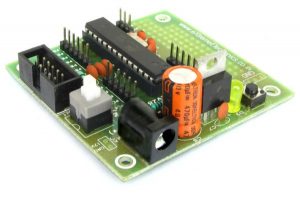In my previous article, I’ve discussed about ATmega32. Now, let me introduce another member of AVR microcontroller family, the ATmega8. This member has many features similar to that of ATmega32. But it has reduced number of features and capabilities, yet it has enough features to work with. Now let me tell you that if you want to gather knowledge and at the same time want to do it in less cost than the budget of ATmega32, you can think of making projects with ATmega8. In that case, one feature you won’t be able to realize is the JTAG interface. But rest of the features are available in this IC. Let us see what one can get from ATmega8.
Here find the pin diagram of Atmega8 microcontroller:-
Memory: It has 8 Kb of Flash program memory (10,000 Write/Erase cycles durability), 512 Bytes of EEPROM (100,000 Write/Erase Cycles). 1Kbyte Internal SRAM
I/O Ports: 23 I/ line can be obtained from three ports; namely Port B, Port C and Port D.
Interrupts: Two External Interrupt source, located at port D. 19 different interrupt vectors supporting 19 events generated by internal peripherals.
Timer/Counter: Three Internal Timers are available, two 8 bit, one 16 bit, offering various operating modes and supporting internal or external clocking.
SPI (Serial Peripheral interface): ATmega8 holds three communication devices integrated. One of them is Serial Peripheral Interface. Four pins are assigned to Atmega8 to implement this scheme of communication.
USART: One of the most powerful communication solutions is USART and ATmega8 supports both synchronous and asynchronous data transfer schemes. It has three pins assigned for that. In many projects, this module is extensively used for PC-Micro controller communication.
TWI (Two Wire Interface): Another communication device that is present in ATmega8 is Two Wire Interface. It allows designers to set up a commutation between two devices using just two wires along with a common ground connection, As the TWI output is made by means of open collector outputs, thus external pull up resistors are required to make the circuit.
Analog Comparator: A comparator module is integrated in the IC that provides comparison facility between two voltages connected to the two inputs of the Analog comparator via External pins attached to the micro controller.
Analog to Digital Converter: Inbuilt analog to digital converter can convert an analog input signal into digital data of 10bit resolution. For most of the low end application, this much resolution is enough.
Read more: Avr Atmega8 Microcontroller – An Introduction


